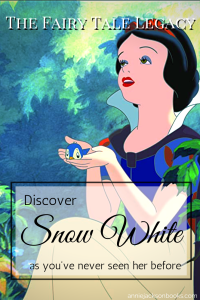We have this false idea that fairy tales are about weak and passive heroines, damsels in distress. So we are always fighting against a fairy tale legacy that doesn’t exist.
Snow White is a bit of a confounding fairy tale and in 1937, Disney did it no favors.
We all know the essence of the story – the envy and vanity of the queen, the huntsman and the dwarves and the poison apple.
Snow White was the first full length animated feature Disney made and their Snow White is sweet and soft spoken and a bit naïve. But there’s a reason for that.
In the original Grimm fairy tale, she’s little more than 7 years old.
Disney aged her physically but left her with the character of a child. And it kind of makes sense, because they were making a kid’s movie. They wanted it to appeal to children and little girls. So Disney gave them a heroine they could relate to.
The three most problematic of the Disney films are Sleeping Beauty, Cinderella and Snow White. And while the first two heroines have virtue and agency we perhaps don’t give them enough credit for, a lot of Snow White’s issues are a result of an absolutely beloved, but poorly developed film.
In Grimm’s fairy tale Snow White is naive and childish because she is a child. Children don’t always recognize danger. Adults lie to them and trick them and we don’t (in good conscience) fault the child for not knowing any better. We teach them what danger looks like and advise them on how to avoid or escape it in the future. In short, we don’t expect the same things from children that we do from older characters.
So, when we examine Snow White’s agency in the fairy tale, she does well for a child. She asks the huntsman to spare her life. Which is a fairly basic thing we wouldn’t give an adult much credit for. But a 7 year old who has the courage to stop this presumably fierce and intimidating man (I mean his job is to kill things) as he’s drawing a knife to pierce her heart deserves a little bit of credit.
She runs away and though she’s scared, she makes it to safety. Then she makes friends and builds a life for herself. She impacts the lives of those friends – improving their living circumstances and their character. She works hard. As the story progresses, she becomes less naive and evades some of the queen’s snares. Though she’s finally undone by her kindness. One could argue she saved herself from a dreadful life several times before the prince ever shows up.
And that’s when we get to the gray area, even with Grimm. We don’t really have a frame of reference for how long she lived with the dwarves or how much she grew up. If it’s not at least 9 years then it’s really inappropriate once the prince shows up and falls in love with her.
He doesn’t kiss her. He doesn’t really even save her from anything. This idea we have that princes do that sort of thing is entirely false. His servants trip and the apple dislodges while he’s taking her home. And then he asks to marry her because he’s in love. Instalove at it’s finest, ladies and gentlemen.
Disney may have aged her to make the whole prince storyline work. Good change but if you’re going to do that, you need to make it a holistic change. And that’s the problem with this film that has carried over into our cultural perception of fairy tale heroines for generations. They kept her as a 7 year old in a 15/16 year old body. Creating, if not a grown woman at the very least a teenager, with the character of a child. They also kept the love that animals have for her.
For decades Snow White has been criticized (even by Disney in other stories) as being passive, naive, weak, syrupy sweet… all manner of problems with this heroine. When it really isn’t that there’s something wrong with her. The problem is the contradiction in the story between her physical age and her mental/emotional age.

It would be far better to leave her young and drop the romance from the story.
Or let her be young, grow up as she lives with the dwarves and learns and matures from her different encounters with the queen. Then when the prince comes along she’s both an appropriate age and emotionally and mentally much different than she was as a 7 year old.
Or age her both physically and mentally from the beginning – give her the maturity of a woman who can recognize danger and is appropriate to fall in love with. It makes it harder for the queen to trick her into eating the poison apple but that dilemma could make for a far more interesting story.
Undoubtedly, the Grimm brothers gave us a fairy tale with a grey area. If you’re going to retell it, you get to choose the poison of how you’ll handle the story you’re given.

THE FAIRY TALE LEGACIES
Sleeping Beauty | Cinderella | Beauty and the Beast | The Little Mermaid | Snow White and Rose Red | Rapunzel | Jasmine | Twelve Dancing Princesses | Snow White | The Snow Queen | Overview
Want to refresh your memory of the fairy tale? SurLaLune fairy tales has an annotated version of the Brothers Grimm tale. And Angie has a great comparison of the fairy tale and Disney movie as part of her Project Disney.

Again, I hadn’t really thought of this story in the context that she is supposed to be a child! I realize that when I read the tale, but I guess the Disney version just made me take for granted that it’s normal for such a naive girl to be a teenager too. What you say makes so much sense though – it would have been interesting to have the first Disney film have a child as a main character. That would have been very relatable for kids, although the appeal to adults might not have been there.
I think Snow White and the Huntsman touch on the child aspect of Snow White because it all goes awry when she’s a kid – then they trap her in a tower for a decade to age her to the point where she can handle the romance and the adventure. I also wonder about Once Upon a Time – not sure if you watch that show. But the main conflict between the evil queen and Snow White happens when she’s a child too. But the story picks up once she’s an adult so that gap in her age is closed. I think the Disney film with her as a child would be really interesting! It would definitely change the dynamic between her and the dwarves. Or maybe not that much, it’s been a while since I’ve watched it 🙂
That’s interesting that she’s a child in the original story! And “instalove at it’s finest, ladies and gentlemen,” ha! It’s true that instalove has been a plot device for a long, long time (look at Romeo and Juliet)!
I didn’t realize she was a child until I researched it for this post – but it totally changes the perspective, doesn’t it 🙂
Romeo and Juliet is another great example of ancient instalove! That would almost be a good post topic – old world stories where they didn’t care how or why people fell in love, just what happened after. A couple of the greek myths spring to mind…